If the old city walls could talk, Tainan would tell a tumultuous tale of 17th-century Dutch forts, ornate Qing Dynasty temples and Japanese colonial opulence. Incense smoke lingers thick in the air as colorful parades weave through cobbled alleyways; here the spiritual realm remains inextricable from everyday life. And as the best spot to enjoy Taiwanese delicacies, Michelin stars and culinary delights await.
Tainan is oft touted as Taiwan’s city of superlatives: the oldest city, the most temples, the best Taiwanese food and now the most visited tourist destination on the island. This itinerary covers some of the best Tainan has to offer in one weekend.
FRIDAY: CUISINE AND COCKTAILS
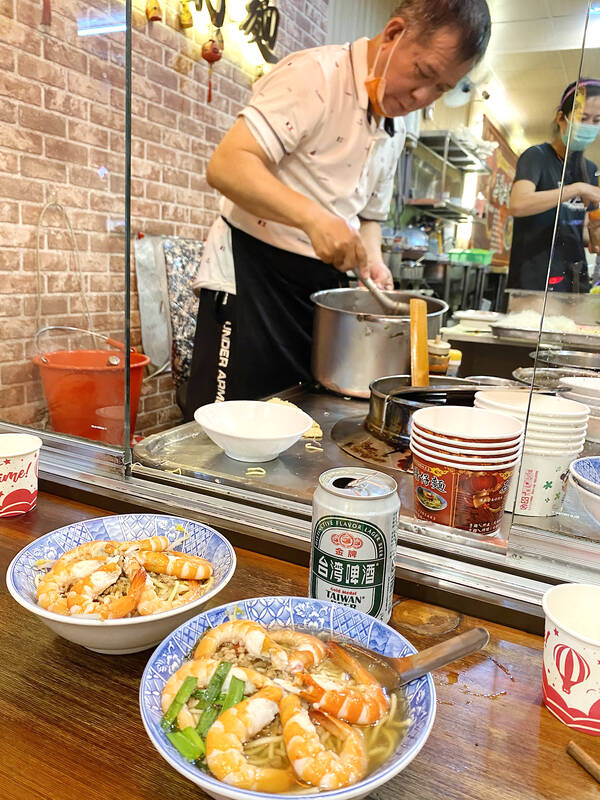
Photo: Hollie Younger
On Friday night, our bullet train hurtles from Taipei Main to Tainan HSR in under 2 hours, and outside the HSR station, a free shuttle bus (H31) is waiting to take us into the city. We chose accommodation close to Fort Provincia (赤崁樓, also known as Chihkan Tower) to be at the center of the action.
For our first introduction to Tainanese cuisine, just a few storefronts from the temple is Shi Chunjiu Danzai Noodles (石精臼擔仔麵). Danzai noodles, translated “peddlers pole noodles,” were historically sold from buckets suspended on the shoulders of humble street vendors.
Sat outside the service window, we cracked a cold can of Taiwan Beer and got a front-row seat to watch the master at work: Chen Tsung-nan (陳宗男) is the second generation to run this mom-and-pop store opened in 1964.
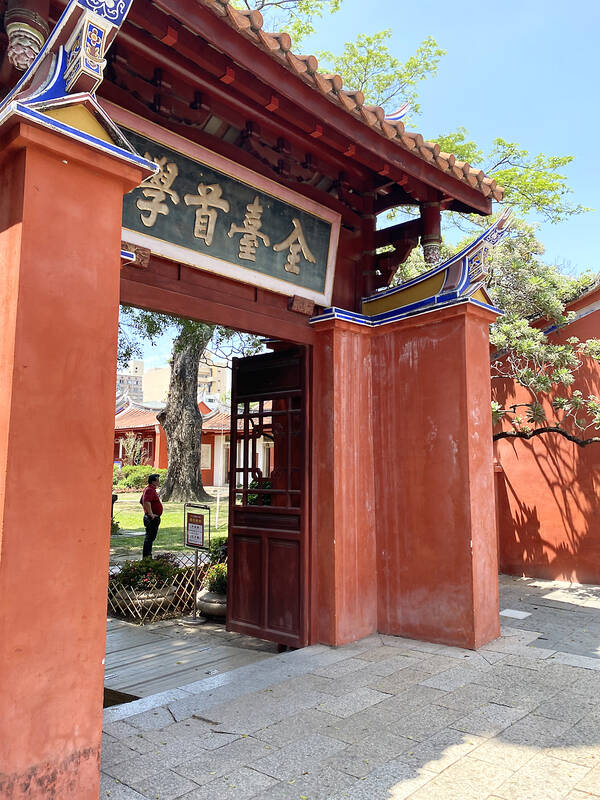
Photo: Hollie Younger
He first ladles in a mild shrimp broth from a giant cauldron that boils away at his feet all night. Then he splashes in silky yellow noodles, the texture contrasting with crisp bean sprouts. He tops it with stewed minced pork and places the cherry on top, a singular flamingo-pink shrimp. The seafood in Tainan tastes so fresh we couldn’t resist the bowl with extra shrimp (NT$180).
For us, no weekend getaway is complete without a tipple or two. Concealed in an unsuspecting alleyway we find Chihkan Pharmacy Speakeasy bar (赤崁中藥行). This hidden bar features romantic dim lighting and the quintessential dark wood banquettes of a traditional Chinese pharmacy. We sample two rounds of medicinally inspired cocktails, challenging our palette with unusual ingredients such as cherry tomato, curried spices and American-style whipped cream, though thankfully not in the same glass. Tainan is home to a selection of hidden bars: these speakeasies and the cocktails we imbibed are detailed in “Tainan’s Speakeasy Cocktail Bars” (Taipei Times, May 1, 2024).
SATURDAY: COLONIAL FEATS AND NIGHT MARKET EATS
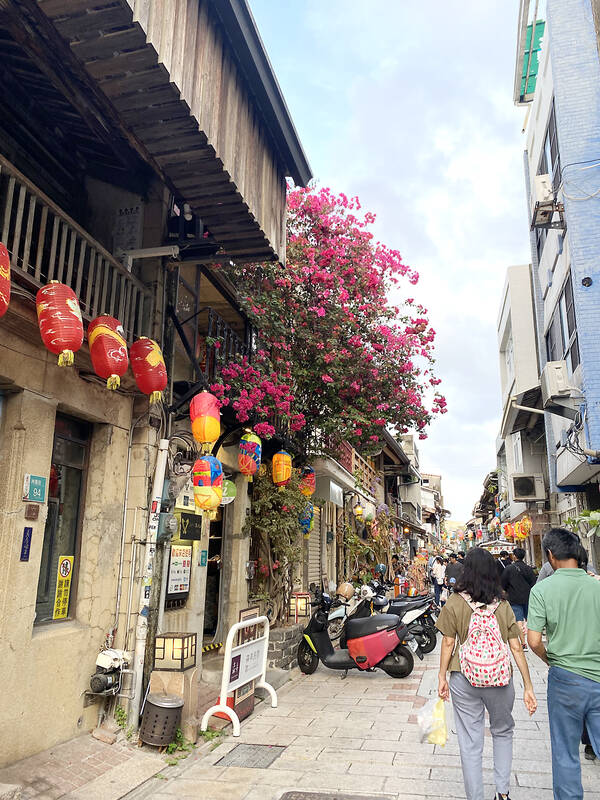
Photo: Hollie Younger
Saturday morning brought us to Anping Old Street (安平老街) for a crispy scallion pancake packed with egg, beansprouts and corn (NT$60) from Tianjin Zhuabing Da Wang (天津抓餅大王). With heads sore from the night before, the greasy familiarity of a flaky pancake drenched in salt-laden sauce is just what the doctor ordered. A local hotspot, they’ll sell out before 10am.
This morning, we’re exploring Anping Fort (安平古堡), a testament to Tainan’s turbulent colonial history. Originally named Fort Zeelandia, it was built by the Dutch occupation starting in 1624. The Ming loyalist Cheng Cheng-kung (鄭成功), also known as Koxinga, took it in 1662, after which Japanese colonizers utilized the site from 1891. The site was then opened for tourists in 1975.
Evidence remains from each regime: the original fort walls, crumbling and draped with greenery, are now invaded by the gnarled roots of the banyan tree. Replicas of canons surround the upper levels, where the Japanese lighthouse, restored, gives fantastic 360 panorama views.
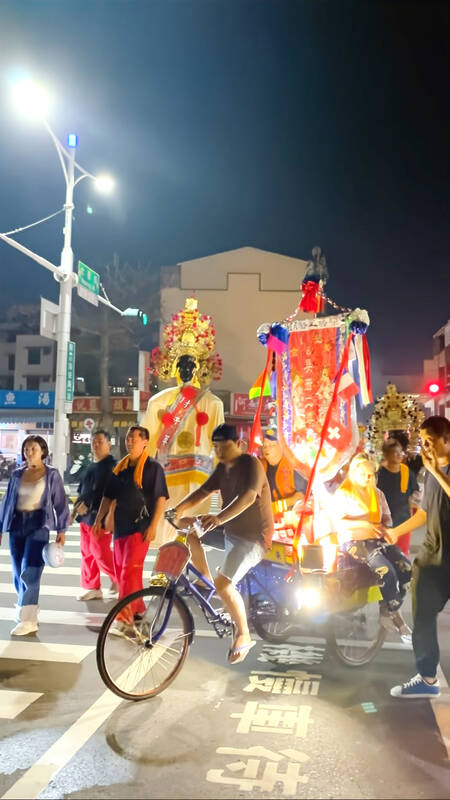
Photo: Hollie Younger
Tainan is famously hot and stinkingly humid: my next stop is for an icy dessert at Anping BB Dan Yuyuan Daren (安平彈芋圓達人), a bustling local joint. Taiwanese desserts are sometimes viewed as overwhelmingly sweet, but it’s all about the contrasting mouthfeel. Crushed ice with black sugar syrup forms the base, then load up your bowl with soft tofu pudding, savory red beans and chewy taro balls. The contrast of cold and warm, sweet and savory, soft and chewy is utterly addictive.
The public transport leaves much to be desired, so we pick up the trusty YouBikes and cycle towards the coast along the palm-tree-lined promenade of Anping Fisherman’s Wharf (安平漁人碼頭). We spend an afternoon on the black-sand beach of Yuguang Island (漁光島), then enjoy a sundowner at Sunset Platform (觀夕平台).
That night, we head for the bright lights of the enormous and oddly titled Flowers Night Market (花園夜市), easily reached by direct shuttle bus from Tainan Station. Although there are indeed no flowers on sale, what can be found is some of the best edible night market fare in Taiwan. Something sorely lacking in Taipei markets is a place to sit and share food. Here, many stalls offer table service, and we jumped at the chance to dine on the benches lining the market’s central strip.
We recommend the unique Yan Shao x Supi Nong Tang (岩燒x酥皮濃湯) right in the center; you’ll spot it from the throngs of barbecuing locals on plastic stools and the wafting fragrance of searing steak. The “surf and turf” platter with beef, enough for two, comes with a personal grill and a plate of steak, snapper, shrimp, calamari and oysters to fry in lardons of salty butter and dip in a punchy black pepper sauce. The set (NT$220) includes a bowl of creamy chicken soup, reminiscent of a New England clam chowder, and a wedge of flaky puff pastry. This stop is as much about the experience and getting stuck in among the market atmosphere as it is the food offering.
Although we didn’t have time, or space in our stomachs, to try the market’s infamous oyster omelets, we hope to catch them next time. Flowers Market also has a fantastic range of clothing stalls, marginally cheaper than Taipei, where I picked up some Korean fashion and some, apparently French, imported perfumes sold from the back of a van: who knew Chanel No.5 retails for only NT$400 down south? Bargain! There’s also a rowdy raffle with locals walking away with blenders, TVs and all manner of household appliances. The games section is also one of the best we’ve seen, offering archery, basketball and BB guns.
SUNDAY: HISTORICAL TOUR AND SPIRITUAL LORE
On Sunday morning, we grabbed a quick breakfast at one of the bakeries encircling Chikan Temple and joined Like It Formosa on their free English-speaking walking tour of Tainan Downtown. Tainan’s historical heritage is the beating heart of the city, and this tour answered every question we had and more.
Our guide Jill, a local university student, enthusiastically led the group through half a millennium of history, not losing our attention for a second. She painted a vivid picture of the city’s former life, from the vermillion gates of the island’s oldest Confucian temple to the Western-inspired facade of Hayashi Department Store, complete with World War II bullet holes.
The tour also encompasses Tainan’s spiritual history, guiding us through grandiose temple complexes and small, unassuming shrines tucked between buildings. Holding claim to the largest statue of Matsu the sea goddess, the Grand Matsu Temple was a great example of how traditional folklore and mainstream religions such as Buddhism have blended together to create a uniquely Taiwanese worship space welcome to all.
Tours meet outside Fort Provincia at 10am and run until 1pm, with plenty of stops including a refreshment break for summer staple winter melon tea with aiyu jelly, famed for its cooling effects.
We booked in advance at www.likeitformosa.com/tour and payment was on a tips-only basis with no minimum spend: we naively tipped poor Jill what we thought was a generous NT$200 each, only to later find that the Web site suggests NT$500 for a great tour — oops. Sorry, Jill.
The tour spits us out right by Sindao Beef Noodle Restaurant (新到刀牛肉麵), what we deem to be the best braised beef noodle soup in all of Taiwan (NT$215). One sip of the broth and a stunned silence descends upon our table: how long must they laboriously simmer the bones to extract such depth of flavor? Thick chunks of finger-rib beef so tender it almost dissolves before one can fully savor it, yet somehow noodles firm and springy until that final, defeated and satisfied slurp. An almost perfect 5-star review status on Google Maps rarely lies.
We walked off the hearty lunch with a stroll through Shennong Street (神農街), one of the city’s most well-preserved “old streets,” adorned with colorful lanterns aglow. Magenta-colored hydrangeas spill from the balconies, cats laze in the sun on parked scooters and each cobbled alleyway has a different offering of vintage clothing, kitsch souvenirs and pop-up markets.
While in the area, we encounter the incoming thrum of beating drums. In Tainan, you really don’t have to look far to find authentic cultural experiences. Almost every weekend, the city celebrates the birthday of a different deity. Statues of the birthday god are paraded in wooden chariots, ridden on flashing LED-lit tricycles or bouncing on the shoulders of dancing pole-bearers. Imposing eight-foot-tall wooden puppets twirl through the streets, the distinctive black faces of the Seventh and Eighth Lords (七爺八爺), as the procession plays trumpets, sets off fireworks and otherwise puts a complete and chaotic halt to the oncoming traffic of West Central District.
Not a confident cyclist at the best of times, I happen to find myself inadvertently trundling into the center of the festivities, caught between festival floats. As the two sweaty foreign girls on You-Bikes, the congregation excitedly shouts out to us, as surprised to see us as we are fascinated by them. The fun and frenzy feel truly a world away from cosmopolitan Taipei.
For the last supper, we head to A-Jiang Eel Noodles (阿江炒鱔魚) for a rustic bowl of one final Tainanese classic. As if in a 1980s time-vortex, the whiskered old proprietor, bent above a giant pan of frying eels, cigarette dangling from his lips, serves up overflowing bowls of slippery eels atop a bed of peppery handmade noodles (NT$130).
With this one final sensory overload, we head back to Taipei, with a fresh perspective on the island’s colonial legacy, cultural identity and culinary heritage, with Tainan its spiritual melting pot and the birthplace of many things we know and love to be Taiwanese.

Not long into Mistress Dispeller, a quietly jaw-dropping new documentary from director Elizabeth Lo, the film’s eponymous character lays out her thesis for ridding marriages of troublesome extra lovers. “When someone becomes a mistress,” she says, “it’s because they feel they don’t deserve complete love. She’s the one who needs our help the most.” Wang Zhenxi, a mistress dispeller based in north-central China’s Henan province, is one of a growing number of self-styled professionals who earn a living by intervening in people’s marriages — to “dispel” them of intruders. “I was looking for a love story set in China,” says Lo,

It was on his honeymoon in Kuala Lumpur, looking out of his hotel window at the silvery points of the world’s tallest twin skyscrapers, that Frank decided it was time to become taller. He had recently confessed to his new wife how much his height had bothered him since he was a teenager. As a man dedicated to self-improvement, Frank wanted to take action. He picked up the phone, called a clinic in Turkey that specializes in leg lengthening surgery — and made a booking. “I had a lot of second thoughts — at the end of the day, someone’s going

In the next few months tough decisions will need to be made by the Taiwan People’s Party (TPP) and their pan-blue allies in the Chinese Nationalist Party (KMT). It will reveal just how real their alliance is with actual power at stake. Party founder Ko Wen-je (柯文哲) faced these tough questions, which we explored in part one of this series, “Ko Wen-je, the KMT’s prickly ally,” (Aug. 16, page 12). Ko was open to cooperation, but on his terms. He openly fretted about being “swallowed up” by the KMT, and was keenly aware of the experience of the People’s First Party
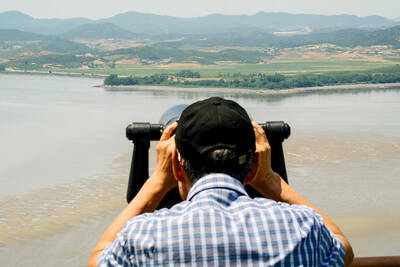
Standing on top of a small mountain, Kim Seung-ho gazes out over an expanse of paddy fields glowing in their autumn gold, the ripening grains swaying gently in the wind. In the distance, North Korea stretches beyond the horizon. “It’s so peaceful,” says the director of the DMZ Ecology Research Institute. “Over there, it used to be an artillery range, but since they stopped firing, the nature has become so beautiful.” The land before him is the demilitarized zone, or DMZ, a strip of land that runs across the Korean peninsula, dividing North and South Korea roughly along the 38th parallel north. This